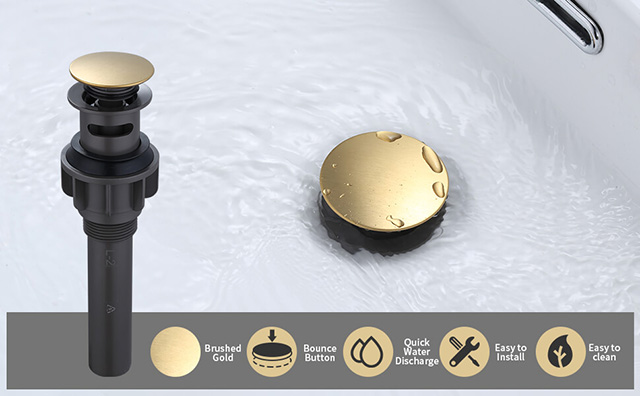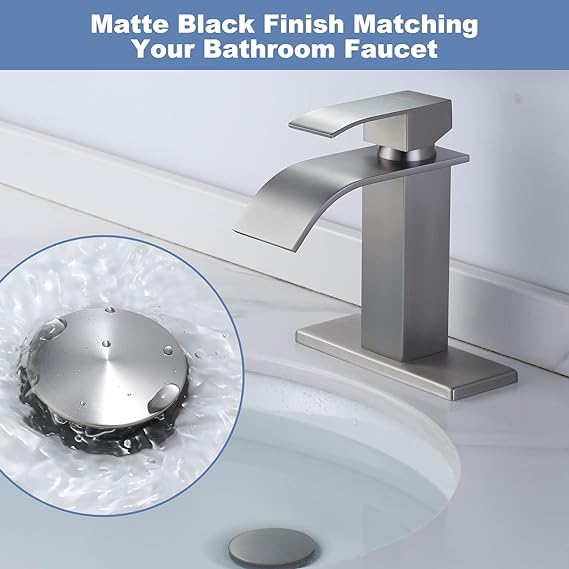Introduction
The bathroom sink is a vital fixture in any home, serving both functional and aesthetic purposes. It is is a fixture designed for washing hands and face, typically featuring a basin with a faucet. Among its many components, the bathroom sink drain plays a crucial role in maintaining a hygienic and efficient bathroom environment. In recent years, the incorporation of overflow features in sink drains has gained popularity due to its added functionality and practicality. This article delves into the intricacies of bathroom sink drain with overflow, exploring their benefits, installation process, and maintenance tips.
I. Understanding the Bathroom Sink Drain
A. Anatomy of a Sink Drain
A sink drain is a relatively simple yet vital part of any bathroom. It comprises several components, including:
- Drain Pipe: This is the pipe that connects the sink to the main plumbing system.
- P-Trap: This U-shaped pipe prevents sewer gases from entering the bathroom.
- Tailpiece: This vertical pipe connects the sink to the P-trap.
- Stopper: The stopper is a plug that can be opened or closed to allow or prevent water from draining.
- Overflow Hole (in sinks with overflow): This is a small hole located near the top of the sink bowl, which allows excess water to drain if the sink is filled too high.
The bathroom sink drain is a fundamental plumbing component responsible for carrying away used water and preventing it from accumulating in the sink bowl. It comprises various parts, each playing a crucial role in its function.
At the heart of the drain is the drain pipe, which connects the sink to the larger plumbing system of the building. Attached to this pipe is the P-trap, a U-shaped section of pipe designed to trap a small amount of water, preventing sewer gases and odors from entering the bathroom. The tailpiece is a vertical pipe connecting the sink bowl to the P-trap.
Controlling the flow of water is the stopper, a plug that can be opened or closed to allow or restrict water from draining. This component comes in various designs, including push-pull, pop-up, and grid-style stoppers.
In sinks equipped with an overflow, there is an additional feature known as the overflow hole. This small aperture, located near the top of the sink bowl, serves as a safety measure. If the water level in the sink becomes too high, instead of overflowing onto the countertop, it is directed into the overflow hole and down the drain.

ARCORA Brushed Gold Bathroom Sink Drain with Overflow
B. Importance of Proper Drainage
A clogged or inefficient drain can lead to unpleasant odors, stagnant water, and potential water damage to the surrounding area.Proper drainage in a bathroom sink is of paramount importance for several reasons. Firstly, it prevents stagnant water, which can harbor harmful bacteria and unpleasant odors. Additionally, efficient drainage safeguards against potential water damage to the surrounding area, including countertops and cabinets. It also contributes to a cleaner and more hygienic environment, reducing the risk of waterborne contaminants. Ultimately, ensuring effective drainage in a sink not only promotes a healthier living space but also prolongs the lifespan and functionality of the plumbing system, saving homeowners from costly repairs and replacements in the long run.
II. The Role of Overflow in Bathroom Sink Drains
A. What is an Overflow?
An overflow is a secondary opening in the sink bowl designed to prevent overflowing. In traditional sinks without an overflow, excess water would spill over the edge, potentially causing a mess.
B. How Does the Overflow Work?
When water reaches a certain level in the sink, instead of spilling over the edge, it flows into the overflow hole and is directed down the drain, preventing any mess.
C. Benefits of an Overflow
- Prevents Water Damage: The overflow prevents water from spilling onto the countertop, protecting it from potential damage.
- Maintains Hygiene: By preventing overflow, it reduces the chances of waterborne contaminants spreading.
- Compliance with Regulations: In many regions, building codes require sinks to have overflows as a safety measure.
III. Installing a Bathroom Sink Drain with Overflow
A. Tools and Materials Needed
Before starting the installation process, gather the necessary tools and materials:
- Wrench
- Plumber’s putty
- Screwdriver
- Plunger
- Piping components (tailpiece, P-trap, etc.)
- Overflow drain kit (if not included)

ARCORA Brushed Nickel Bathroom Sink Pop Up Drain with Overflow
B. Step-by-Step Installation Process
Remove the Old Drain: Begin by disconnecting the old drain. Use a wrench to loosen and remove the nut holding the tailpiece in place.
Apply Plumber’s Putty: Roll a small amount of plumber’s putty into a rope and apply it to the underside of the drain flange. Insert the drain flange into the sink’s drain hole.
Attach the Tailpiece: Connect the tailpiece to the drain flange and tighten it using a wrench.
Install the P-Trap: Connect the P-trap to the tailpiece and the drain pipe, ensuring a secure fit. Use a wrench to tighten the connections.
Attach the Overflow Drain: If the sink doesn’t come with an integrated overflow drain, install it according to the manufacturer’s instructions.
Test for Leaks: Run water into the sink and check for any leaks. If there are leaks, tighten the connections as needed.
IV. Maintenance Tips for Bathroom Sink Drains
Proper maintenance ensures the longevity and efficiency of your sink drain. Here are some tips to consider:
- Regular Cleaning: Use a bathroom sink drain cleaner or a mixture of baking soda and vinegar to prevent buildup.
- Avoid Harsh Chemicals: Refrain from using harsh chemicals, as they can corrode the pipes.
- Check for Leaks: Periodically inspect the connections for any signs of leaks.
- Clear Clogs Promptly: Use a plunger or drain snake to clear minor clogs before they escalate.
- Professional Inspections: Schedule annual inspections with a plumber to identify and address potential issues.
Conclusion
A bathroom sink drain with overflow is a valuable addition to any bathroom, providing both functionality and peace of mind. Understanding its components, benefits, and installation process allows homeowners to make informed decisions when selecting and maintaining this essential fixture. By following proper installation and maintenance practices, you can ensure your bathroom sink drain operates smoothly for years to come, enhancing the overall functionality and aesthetics of your bathroom space.
 ARCORA FAUCETS
ARCORA FAUCETS
